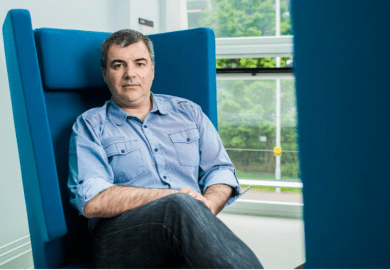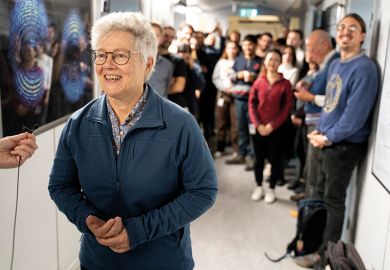Over the past 30 years, scientists have made enormous strides in understanding the nature of our universe at both very large and very small scales.
We now have workable models for events immediately after the Big Bang and the birth of the universe some 14 billion years ago, and ideas about the workings of the smallest fundamental particles. We have a theoretical framework that works for phenomena at the scale of galaxies, and another that works very well at the scale of quantum weirdness. What we lack is a way of marrying the two, and that leaves a number of questions open. Some of these are examined in Paul Davies’ new book, What’s Eating the Universe? And Other Cosmic Questions.
Davies is a British physicist with a broad range of interests, from cosmology and black holes to quantum field theory and astrobiology. Each of these topics is touched on in his book, which starts (appropriately enough) with the still observable remnants of the Big Bang and moves through to how it may all end. However, the book is a gallop – a slim volume that just touches on big questions before moving swiftly on. The result is a little unsatisfying; the reader is directed from one shiny idea to another without really settling down. At one point, Davies includes an anecdote about being a teenager in Buddy Holly glasses telling a girl he wanted to impress that the Sun could explode at any time. That’s rather what this book feels like.
This light touch may also give rise to misconceptions. For example, Davies explains that Neptune was discovered not through direct observation but through its gravitational influence on Uranus, which itself could be directly observed. Neptune is described as “one of a long list of unseen, unseeable or just plain dim entities that were discovered by the way they tug on their more visible neighbours”. “Dark matter” is immediately introduced as analogous, which may leave the unfamiliar reader wondering whether dark matter might be an object we simply can’t see or haven’t observed yet rather than what seems to be a highly prevalent yet mysterious fundamental form of matter that we don’t as yet know enough about to even measure.
I was also left feeling a bit unsure about the titular question: what is eating the universe? On the one hand, the book goes into some detail about supermassive black holes inexorably eating up cosmic matter – stars, gas and dust. But the question apparently refers to an unexplained smudge in the all-sky map we now have that shows the remaining afterglow from the birth of the universe (this residual heat is known as the cosmic microwave background). This smudge is described by Davies as looking like a bite that a giant has taken out of the universe on a truly massive scale. One possible explanation he gives is that our universe has bumped into, or has been sideswiped by, another universe in the multiverse. This somewhat mind-boggling idea is then set aside to discuss the possibility that the universe may instead eat itself by a process of vacuum decay. These very different concepts are all discussed within four pages before moving on.
Even the largest of questions – such as whether the universe has to be the way it is or whether tweaking the laws of physics would give rise to something else, possibly something “better” – are covered in a couple of pages. The obvious issue is then: better for whom or for what? Are we talking about a universe that won’t decay, or won’t eventually eat itself? To the best of our knowledge, there is no particular reason why the fundamental constants – the strengths of fundamental forces or the masses of fundamental particles – have to be what they are. We just know that they are indeed constant wherever in the universe we look. Could a universe come into being if these were different? The answer is, apparently, yes. And then we move on.
Astrobiology is a subject that has gone from the domain of somewhat “crank” science, involving canals on Mars and alien abductions, to a recognised academic discipline. On Earth, astrobiologists explore the limits to life, looking for living species in the most unlikely habitats, surviving and sometimes thriving under extreme conditions. On Earth at least, to borrow from Jurassic Park, life seems to find a way. This knowledge then allows us to consider what conditions might be required for life to exist “out there”, whether “there” is another planet, a moon or an asteroid. If it is out there, what signatures should we be looking for in order to detect it, given we can’t travel very far from our own local environment? Does life out there even have to look like life down here?
Linked to these questions is the conundrum of how life started on Earth in the first place. Given a certain set of conditions, is kick-starting life quite straightforward, just requiring a lot of time? Biological timescales are minuscule on the scale of the universe, so time is something we have plenty of to play with. However, this presents a further challenge: that intelligent life might have arisen elsewhere in the universe, but then petered out in the billions of years before Earth existed or could itself sustain life. For this reason, Davies posits that if we encounter anything, they are more likely to take the form of robots or artificial surrogates than biological organisms, machines that can survive time and inhospitable conditions. Trying to find one of them, however, is looking for the ultimate needle in a fathomless haystack.
The book concludes by asking whether there is a meaning to it all and considering future prospects for cosmology and fundamental physics. One notion that I very much enjoyed is that the universe has somehow evolved not just awareness but also comprehension of itself. Our fleshy bodies of mindless jiggling atoms that come together to consume energy to power neurons have somehow reached a state that means we can not only look at and measure the universe, but also work out the order and rules behind it all – or at least a lot of it. Put that way, it is nothing short of astonishing. You are astonishing.
Fundamentally, then, What's Eating the Universe? gives a concise summary of what we know about the universe, including the Big Bang, inflation, the existence (but not the details) of what we call dark matter and dark energy, the possibility of other universes, black holes and the nature of time – all in around 150 accessible and beautifully written pages that can be read in short, discrete chunks. As a whistle-stop tour, it is breathtaking, although other popular science books or sources may be required to give deeper satisfaction, to provide that true “aha moment” and to clarify some of the ideas that are sketched only in outline. As a gateway book, however, What’s Eating the Universe? is a good place to start.
Cait MacPhee is professor of biological physics at the University of Edinburgh.
What’s Eating the Universe? And Other Cosmic Questions
By Paul Davies
Allen Lane, 192pp, £16.99
ISBN 9780241459850
Published 2 September 2021
The author
Paul Davies, Regents’ professor of physics at Arizona State University, grew up in London and studied at University College London before going on to a PhD. He worked at several British universities (1970-90) and then three more in Australia (1990-2006) before joining ASU.
His core research is on “quantum gravity, early universe cosmology, the theory of quantum black holes and the nature of time”. But Davies has also worked on astrobiology and involved in a cancer research project on a “shoestring” budget, he once told Times Higher Education, designed to “break totally new conceptual ground, not just using gadgets to zap the disease”. And he is equally committed to the Search for Extraterrestrial Intelligence (Seti), where his position as chair of the post-detection task group meant that it would be his job to initiate the ice-breaking conversation with any aliens that showed up.
Alongside his own research work, however, Davies is an acclaimed scientific populariser. His books, such as Superstrings: A Theory of Everything? (1988), About Time: Einstein’s Unfinished Revolution (1995) and How to Build a Time Machine (2001), explore the dizzying frontiers of physics. Yet he has also been unafraid to address broader questions of purpose, and how we can explain the emergence of conscious and intelligent life. He once admitted that he would "feel much happier about a universe in which we are at home” and didn’t “think we [humans] are a monumental irrelevance”. But although his provisional view was that "we are probably the only intelligent beings in the universe”, he still retained a “wide-eyed schoolboy fascination” with the possibility of aliens. Such themes are examined in depth in The Mind of God: The Scientific Basis for a Rational World (1992), The Goldilocks Enigma: Why Is the Universe Just Right for Life? (2006) and The Eerie Silence: Are We Alone in the Universe? (2010).
Matthew Reisz
POSTSCRIPT:
Print headline: Light-year leaping through physics
Register to continue
Why register?
- Registration is free and only takes a moment
- Once registered, you can read 3 articles a month
- Sign up for our newsletter
Subscribe
Or subscribe for unlimited access to:
- Unlimited access to news, views, insights & reviews
- Digital editions
- Digital access to THE’s university and college rankings analysis
Already registered or a current subscriber? Login







